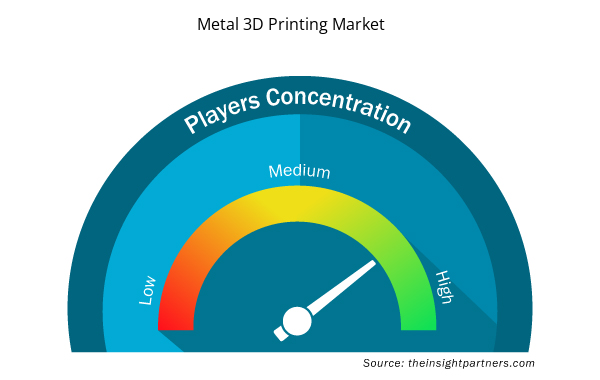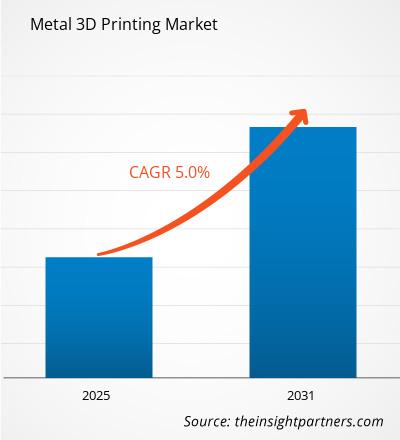金属 3D プリンティング市場は、 2023 年から 2031 年にかけて 5% のCAGR を記録し、市場規模は 2023 年の XX 百万米ドルから 2031 年には XX 百万米ドルに拡大すると予想されています。
レポートは、金属の種類(チタン、ニッケル、ステンレス鋼、アルミニウム、その他)別にセグメント化されています。レポートではさらに、フォーム(粉末、フィラメント、その他)に基づいた分析を提示しています。最終用途に基づいて、レポートは(航空宇宙および防衛、自動車、医療、建設、その他)に分類されています。グローバル分析は、地域レベルと主要国でさらに細分化されています。レポートは、上記の分析とセグメントに対してUSDでの値を提供します。上記の分析およびセグメントのUSD 。
報告書の目的
The Insight Partners による金属 3D 印刷市場レポートは、現在の状況と将来の成長、主な推進要因、課題、機会を説明することを目的としています。これにより、次のようなさまざまなビジネス関係者に洞察が提供されます。
- テクノロジープロバイダー/メーカー: 進化する市場の動向を理解し、潜在的な成長機会を把握することで、情報に基づいた戦略的意思決定が可能になります。
- 投資家: 市場の成長率、市場の財務予測、バリュー チェーン全体に存在する機会に関する包括的な傾向分析を実施します。
- 規制機関: 市場の濫用を最小限に抑え、投資家の信用と信頼を維持し、市場の完全性と安定性を維持することを目的として、市場における政策と警察活動を規制します。
金属3Dプリント市場のセグメンテーション
金属タイプ
- チタン
- ニッケル
- ステンレス鋼
- アルミニウム
形状
- 粉
- フィラメント
最終用途
- 航空宇宙および防衛
- 自動車
- 医学
- 工事
地理
- 北米
- ヨーロッパ
- アジア太平洋
- 南米と中央アメリカ
- 中東およびアフリカ
地理
- 北米
- ヨーロッパ
- アジア太平洋
- 南米と中央アメリカ
- 中東およびアフリカ
要件に合わせてレポートをカスタマイズする
このレポートの一部、国レベルの分析、Excelデータパックなど、あらゆるレポートを無料でカスタマイズできます。また、スタートアップや大学向けのお得なオファーや割引もご利用いただけます。
- このレポートの主要な市場動向を入手してください。この無料サンプルには、市場動向から見積もりや予測に至るまでのデータ分析が含まれます。
金属3Dプリント市場の成長要因
- 航空宇宙および自動車産業からの需要の高まり: 航空宇宙および自動車産業は、軽量で複雑な部品製造ソリューションの金属 3D 印刷市場の成長を牽引しています。この 2 つの業界は、燃費、性能、排出量を改善するために軽量化に重点を置いています。金属 3D 印刷では、軽量化しながら複雑なデザインを作成できます。
- 航空宇宙部品の革命: 金属 3D プリントは、タービン ブレード、ブラケット、その他の構造部品などの航空宇宙部品に革命をもたらしました。従来の製造方法では設計が制限されますが、積層造形では複雑な形状を使用し、通常は強度を損なうことなく重量を減らすことができます。したがって、この新しい方法により、航空機の性能が向上し、効率がさらに向上し、市場の成長が促進されます。
- 自動車の性能と効率の向上: 同様に、自動車部門では、金属 3D プリントによる軽量で高性能な部品の製造が進んでいます。メーカーが使用するチタン、アルミニウム、ステンレス鋼などの材料のほとんどは、非常に効率的で耐久性がありながら複雑なデザインの部品を生産します。これにより燃費とハンドリングが向上し、自動車製造における金属 3D プリント技術の需要が高まります。
金属 3D プリント市場の将来動向
- 性能が向上した高度な金属粉末: 高性能の高度な金属粉末は、金属 3D 印刷市場の成長を促進する将来のトレンドの 1 つです。このような粉末は、強度、耐熱性、腐食損傷など、さらに優れた特性を与えます。このような高度な材料は、さまざまな使用条件に耐える必要があり、より高い耐久性と高性能基準が求められるコンポーネントを製造する業界で見られる 3D 印刷アプリケーションにますます必要になってきています。
- 耐久性と性能の向上: 高度な金属粉末により、航空宇宙や自動車などの分野での非常に高い温度や機械的ストレスなどの極限条件に耐えられる部品の製造が可能になります。これにより、エンジン、タービン、車両の構造の重要な部品の効率と寿命に直接的な効果をもたらす、より軽量で強度の高い部品の印刷が可能になります。これも市場の成長を促進します。
- 業界を変革する新しい合金とカスタマイズされた金属粉末: 新しい合金とカスタマイズされた金属粉末の開発は、医療機器やツールなどの業界でも鉄の革新を推進しています。これらの「エキゾチック」な材料により、インプラントの即時生体適合性や産業用ツールのはるかに高い硬度など、特定の用途に最適化された特性を持つ、まったく前例のない複雑な形状を作成できます。顧客から求められるパーソナライズと高品質が高まれば高まるほど、高度な金属粉末が 3D 印刷に採用されるスピードと量も増えます。
金属 3D プリント市場の機会
- 高価値コンポーネントの迅速なプロトタイピングと製造: 金属 3D プリント市場は、迅速なプロトタイピングと高価値コンポーネントの製造によって大きく活性化しています。プロトタイプ製造により、業界全体で設計テスト サイクル、開発時間、製造プロセスが短縮され続けています。これは、航空宇宙、自動車、医療機器などの重要な分野で特に当てはまります。
- 航空宇宙および自動車産業における金属ラピッドプロトタイピングによるイノベーションの加速: 航空宇宙および自動車産業の両方の製造において、金属ラピッドプロトタイピングはイノベーションサイクルの高速化に不可欠です。ラピッドプロトタイプでは、エンジニアは設計を迅速に反復し、テストを通じて調整を行ってから、市場投入までの時間を短縮できます。その結果、開発が加速し、設計の改善によって精度が向上し、コンポーネントの性能とコスト効率が向上します。これらすべてが、金属 3D プリントに関連するテクノロジーの需要の増加につながります。
- 高価値コンポーネントとカスタマイズ: この市場の成長のもう一つの原動力は、タービンブレード、エンジン部品、および非常に複雑な医療用インプラント用の高価値コンポーネントの製造です。金属 3D プリントでしか実現できないような高性能で複雑な幾何学的コンポーネントは、従来のエンジニアリング手法では製造できません。多くの場合、特定の特性が求められる、高度にカスタマイズされた、強力でありながら軽量なコンポーネントは、通常、前述の業界で価値があります。
金属 3D プリント市場の地域別分析
予測期間を通じて金属 3D 印刷市場に影響を与える地域的な傾向と要因は、Insight Partners のアナリストによって徹底的に説明されています。このセクションでは、北米、ヨーロッパ、アジア太平洋、中東およびアフリカ、南米および中米にわたる金属 3D 印刷市場のセグメントと地理についても説明します。

- 金属3Dプリント市場の地域別データを入手
金属3Dプリント市場レポートの範囲
| レポート属性 | 詳細 |
|---|---|
| 2023年の市場規模 | XX百万米ドル |
| 2031年までの市場規模 | XX百万米ドル |
| 世界のCAGR(2023年~2031年) | 5% |
| 履歴データ | 2021-2022 |
| 予測期間 | 2024-2031 |
| 対象セグメント | 金属の種類別
|
| 対象地域と国 | 北米
|
| 市場リーダーと主要企業プロフィール |
|
金属 3D プリント市場のプレーヤーの密度: ビジネス ダイナミクスへの影響を理解する
金属 3D 印刷市場は、消費者の嗜好の変化、技術の進歩、製品の利点に対する認識の高まりなどの要因により、エンドユーザーの需要が高まり、急速に成長しています。需要が高まるにつれて、企業は提供を拡大し、消費者のニーズを満たすために革新し、新たなトレンドを活用し、市場の成長をさらに促進しています。
市場プレーヤー密度とは、特定の市場または業界内で活動している企業または会社の分布を指します。これは、特定の市場スペースに、その市場規模または総市場価値に対してどれだけの競合相手 (市場プレーヤー) が存在するかを示します。
金属 3D プリント市場で事業を展開している主要企業は次のとおりです。
- EOS
- コンセプトレーザー
- SLMソリューション
- レニショー
- 添加剤産業
- GEアディティブ
免責事項:上記の企業は、特定の順序でランク付けされていません。

- 金属3Dプリント市場のトップキープレーヤーの概要を入手
主なセールスポイント
- 包括的なカバレッジ: レポートでは、金属 3D 印刷市場の製品、サービス、タイプ、エンド ユーザーの分析を包括的にカバーし、全体的な概要を提供します。
- 専門家による分析: レポートは、業界の専門家とアナリストの深い理解に基づいてまとめられています。
- 最新情報: このレポートは、最新の情報とデータの傾向を網羅しているため、ビジネスの関連性を保証します。
- カスタマイズ オプション: このレポートは、特定のクライアント要件に対応し、ビジネス戦略に適切に適合するようにカスタマイズできます。
したがって、金属 3D 印刷市場に関する調査レポートは、業界のシナリオと成長の見通しを解読して理解する道の先導役となる可能性があります。いくつかの正当な懸念があるかもしれませんが、このレポートの全体的な利点は欠点を上回る傾向があります。
- 過去2年間の分析、基準年、CAGRによる予測(7年間)
- PEST分析とSWOT分析
- 市場規模価値/数量 - 世界、地域、国
- 業界と競争環境
- Excel データセット


- Clinical Trial Supplies Market
- Vision Care Market
- Malaria Treatment Market
- Biopharmaceutical Contract Manufacturing Market
- Long Read Sequencing Market
- Electronic Toll Collection System Market
- Public Key Infrastructure Market
- Sandwich Panel Market
- Machine Condition Monitoring Market
- Pipe Relining Market

Report Coverage
Revenue forecast, Company Analysis, Industry landscape, Growth factors, and Trends

Segment Covered
This text is related
to segments covered.

Regional Scope
North America, Europe, Asia Pacific, Middle East & Africa, South & Central America

Country Scope
This text is related
to country scope.
よくある質問
Advanced Metal Powders with Improved Performance is expected to be the key market trends.
Based on geography, Asia Pacific held the largest share of the metal 3D printing market.
Based on metal type, aluminum is expected to witness the fastest growth during the forecast period
EOS, Concept Laser, SLM Solutions are some of the key players operating in the metal 3D printing market
Growing Demand from Aerospace and Automotive Industries is driving the market growth
The Metal 3D Printing Market is estimated to witness a CAGR of 5% from 2023 to 2031
Trends and growth analysis reports related to Chemicals and Materials : READ MORE..
The Insight Partners performs research in 4 major stages: Data Collection & Secondary Research, Primary Research, Data Analysis and Data Triangulation & Final Review.
- Data Collection and Secondary Research:
As a market research and consulting firm operating from a decade, we have published and advised several client across the globe. First step for any study will start with an assessment of currently available data and insights from existing reports. Further, historical and current market information is collected from Investor Presentations, Annual Reports, SEC Filings, etc., and other information related to company’s performance and market positioning are gathered from Paid Databases (Factiva, Hoovers, and Reuters) and various other publications available in public domain.
Several associations trade associates, technical forums, institutes, societies and organization are accessed to gain technical as well as market related insights through their publications such as research papers, blogs and press releases related to the studies are referred to get cues about the market. Further, white papers, journals, magazines, and other news articles published in last 3 years are scrutinized and analyzed to understand the current market trends.
- Primary Research:
The primarily interview analysis comprise of data obtained from industry participants interview and answers to survey questions gathered by in-house primary team.
For primary research, interviews are conducted with industry experts/CEOs/Marketing Managers/VPs/Subject Matter Experts from both demand and supply side to get a 360-degree view of the market. The primary team conducts several interviews based on the complexity of the markets to understand the various market trends and dynamics which makes research more credible and precise.
A typical research interview fulfils the following functions:
- Provides first-hand information on the market size, market trends, growth trends, competitive landscape, and outlook
- Validates and strengthens in-house secondary research findings
- Develops the analysis team’s expertise and market understanding
Primary research involves email interactions and telephone interviews for each market, category, segment, and sub-segment across geographies. The participants who typically take part in such a process include, but are not limited to:
- Industry participants: VPs, business development managers, market intelligence managers and national sales managers
- Outside experts: Valuation experts, research analysts and key opinion leaders specializing in the electronics and semiconductor industry.
Below is the breakup of our primary respondents by company, designation, and region:

Once we receive the confirmation from primary research sources or primary respondents, we finalize the base year market estimation and forecast the data as per the macroeconomic and microeconomic factors assessed during data collection.
- Data Analysis:
Once data is validated through both secondary as well as primary respondents, we finalize the market estimations by hypothesis formulation and factor analysis at regional and country level.
- Macro-Economic Factor Analysis:
We analyse macroeconomic indicators such the gross domestic product (GDP), increase in the demand for goods and services across industries, technological advancement, regional economic growth, governmental policies, the influence of COVID-19, PEST analysis, and other aspects. This analysis aids in setting benchmarks for various nations/regions and approximating market splits. Additionally, the general trend of the aforementioned components aid in determining the market's development possibilities.
- Country Level Data:
Various factors that are especially aligned to the country are taken into account to determine the market size for a certain area and country, including the presence of vendors, such as headquarters and offices, the country's GDP, demand patterns, and industry growth. To comprehend the market dynamics for the nation, a number of growth variables, inhibitors, application areas, and current market trends are researched. The aforementioned elements aid in determining the country's overall market's growth potential.
- Company Profile:
The “Table of Contents” is formulated by listing and analyzing more than 25 - 30 companies operating in the market ecosystem across geographies. However, we profile only 10 companies as a standard practice in our syndicate reports. These 10 companies comprise leading, emerging, and regional players. Nonetheless, our analysis is not restricted to the 10 listed companies, we also analyze other companies present in the market to develop a holistic view and understand the prevailing trends. The “Company Profiles” section in the report covers key facts, business description, products & services, financial information, SWOT analysis, and key developments. The financial information presented is extracted from the annual reports and official documents of the publicly listed companies. Upon collecting the information for the sections of respective companies, we verify them via various primary sources and then compile the data in respective company profiles. The company level information helps us in deriving the base number as well as in forecasting the market size.
- Developing Base Number:
Aggregation of sales statistics (2020-2022) and macro-economic factor, and other secondary and primary research insights are utilized to arrive at base number and related market shares for 2022. The data gaps are identified in this step and relevant market data is analyzed, collected from paid primary interviews or databases. On finalizing the base year market size, forecasts are developed on the basis of macro-economic, industry and market growth factors and company level analysis.
- Data Triangulation and Final Review:
The market findings and base year market size calculations are validated from supply as well as demand side. Demand side validations are based on macro-economic factor analysis and benchmarks for respective regions and countries. In case of supply side validations, revenues of major companies are estimated (in case not available) based on industry benchmark, approximate number of employees, product portfolio, and primary interviews revenues are gathered. Further revenue from target product/service segment is assessed to avoid overshooting of market statistics. In case of heavy deviations between supply and demand side values, all thes steps are repeated to achieve synchronization.
We follow an iterative model, wherein we share our research findings with Subject Matter Experts (SME’s) and Key Opinion Leaders (KOLs) until consensus view of the market is not formulated – this model negates any drastic deviation in the opinions of experts. Only validated and universally acceptable research findings are quoted in our reports.
We have important check points that we use to validate our research findings – which we call – data triangulation, where we validate the information, we generate from secondary sources with primary interviews and then we re-validate with our internal data bases and Subject matter experts. This comprehensive model enables us to deliver high quality, reliable data in shortest possible time.


 このレポートの無料サンプルを入手する
このレポートの無料サンプルを入手する